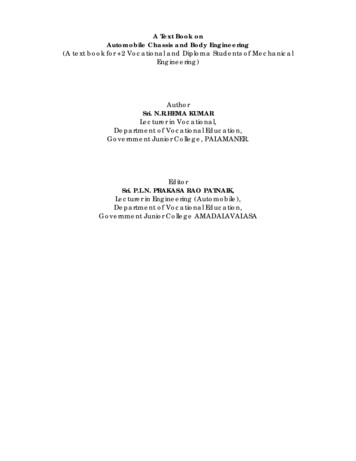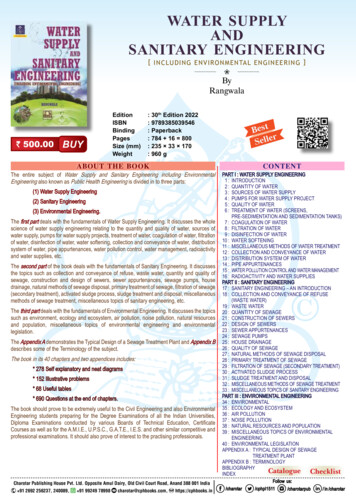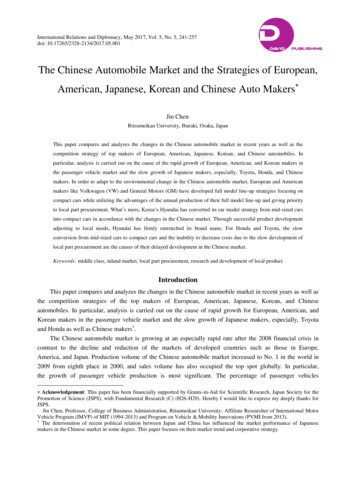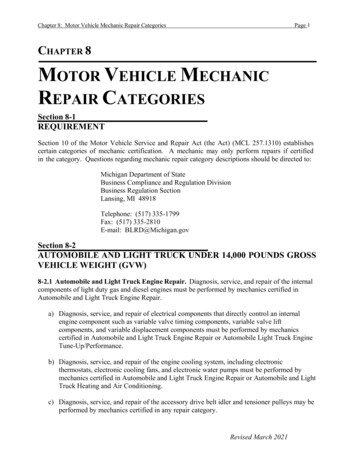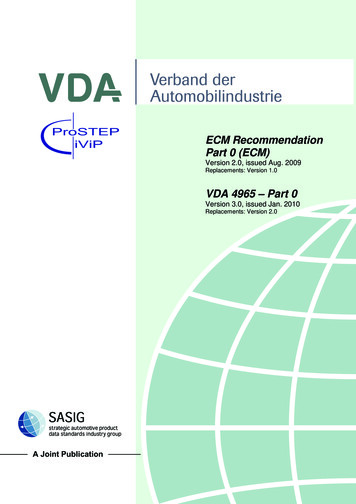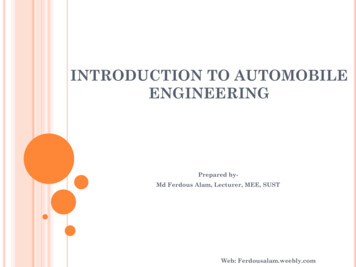
Transcription
INTRODUCTION TO AUTOMOBILEENGINEERINGPrepared byMd Ferdous Alam, Lecturer, MEE, SUSTWeb: Ferdousalam.weebly.com
HELLO CLASS: GOOD MORNING!
The term automobile is derivedfrom the Greek word “autos”,which means self,and the French word “mobile”,which means moving.
FACTS Automobiles have around more than 100 years Originally called horseless carriagesToday more than 130 million cars in the U.S. One-third of cars in the world The official land-speed record (measured over onemile) is 1,227.985 km/h!!!!!!!!!!!!!!!!!!!!!!!oTotal registered vehicles inBangladesh 1030864
TOP SPEED 299 KM/H007ASTON MARTIN DB9 V12
A SHORT HISTORY LESSON!In 1807 François Isaac de Rivaz designed thefirst car powered by an internal combustionengine fueled by hydrogen In 1886, Karl Benz developed a petrol or gasolinepowered automobile. This is also considered to bethe first "production" vehicle as Benz madeseveral other identical copies. The automobilewas powered by a single cylinder two strokeengine. Henry Ford made mass production.
Karl BenzHenry Ford
AUTOMOBILE Automobile is a vehicle driven by an internalcombustion engine.Automobile Engineering is a branchof engineering which deals with designing,manufacturing and operating automobiles.
Some Important Terms
WHAT ARE PART, ASSEMBLY & COMPONENT A part is the smallest removable item on a car. Apart is not normally disassembled.The word component is frequently used whenreferring to an electrical or electronic part. Forexample, a spark plug is an ignition systemcomponent that ignites the fuel in the engine.
An assembly is a set of fitted parts designed tocomplete a function.For example, the engine is an assembly thatconverts fuel into useable power to move thevehicle.
FRAME AND BODY The frame is the strong metal structure thatprovides a mounting place for the other parts ofthe vehicleThe frame holds the engine, transmission,suspension, and other assemblies in position.The body is a steel, aluminum, fiberglass, plastic,or composite skin forming the outside of thevehicle. The body is painted to give the vehicle anattractive appearance
CHASSIS OF AN AUTOMOBILE The term chassis is often used when referring toa vehicle’s frame and everything mounted to itexcept the body—tires, wheels, engine,transmission, drive axle assembly, and frame.
BODY FRAMETo support the vehicle's mechanical componentsand body To deal with static and dynamic loads, withoutundue deflection or distortion. Weight of the body, passengers, and cargo loads.Vertical and torsional twisting transmitted by goingover uneven surfaces.Transverse lateral forces caused by road conditions,side wind, and steering the vehicle.Torque from the engine and transmission.Longitudinal tensile forces from starting andacceleration, as well as compression from braking.Sudden impacts from collisions.
TYPES OF CONSTRUCTION OF AUTOMOBILE 1. Body-over-frame construction 2. Unibody construction
A unibody frame is a type of vehicleconstruction where the both the body of the carand the chassis forms a single unit;reinforcements are then added to other specificsections of the car.Body-on-frame is an automobile constructionmethod by which a separate body is mounted ona relatively rigid frame or chassis that carriesthe engine and drivetrain.
BASIC FEATURES OF AUTOMOTIVE BODY: Body and frame—support and enclose thevehicleEngine—provides dependable, efficient powerfor the vehicleComputer systems—monitor and controlvarious vehicle systems.Fuel system—provides a combustible air-fuelmixture to power the engine.
Electrical system—generates and/or distributesthe power needed to operate the vehicle’selectrical and electronic components.Cooling and lubrication systems—preventengine damage and wear by regulating engineoperating temperature and reducing frictionbetween internal engine parts.
Exhaust and emission control systems—quiet engine noise and reduce toxic substancesemitted by the vehicle.Drive train systems—transfer power from theengine to the drive wheels.Suspension, steering, and brake systems—support and control the vehicle.Accessories and safety systems—increaseoccupant comfort, safety, security, andconvenience.
Suspension is the system of tires, tire air,springs, shock absorbers and linkages thatconnects a vehicle to its wheels and allowsrelative motion between the two.
THANK YOU
powered automobile. This is also considered to be the first "production" vehicle as Benz made several other identical copies. The automobile was powered by a single cylinder two stroke . of engineering which deals with des
